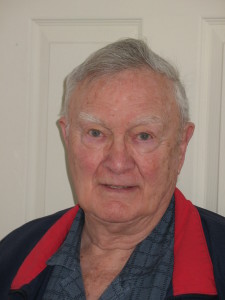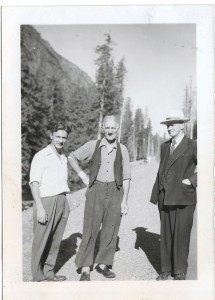
April 2015
Eric Goodfellow of Princeton may be the only individual who ever walked the rugged mountainous trail from Princeton to Hope at the age of 7.
He sent me an e-mail after reading my column about Bill Robinson’s cabin at Camp Defiance along the Hope-Princeton Highway. My research had not led me to any living persons who had walked the trail in those early years. For this reason his words surprised me. “I walked with my father from Princeton to Hope in 1934. We stopped in at the cabin and visited with Bill Robinson. He gave us coffee with sugar.”
Hoping he might be able to expand my understanding of this aspect of BC geography and history, I invited him for coffee and a conversation. When he arrived at my home in Hedley at 10:00 a.m. as arranged, I sensed immediately that he is a congenial individual who enjoys people. He began by saying, “In 1927 my father, Reverend John C. Goodfellow, was invited to become pastor of the United Church in Princeton. I was only 6 weeks old when we moved from Victoria. The first time I walked the trail with him was in 1934. All I carried that time was a pillow. He carried our sleeping bags and food.”
In answer to my question as to his father’s motivation for undertaking such an arduous and unlikely trek, Eric said, “He took along 10-15 boys. They were mostly from the Sunday School in his church, but other boys were welcome. He didn’t talk much about religion on these walks. I think he just wanted to develop relationships with the boys and build into their young lives. He walked the trail 19 times, always starting out on the first Monday of July. All told he took along a total of about 250 boys. The last 2 years a Mrs. Busche came along, each time with a group of girls.”
They began their trek on the section of highway from Princeton to Fraser Camp, (the Whipsaw Creek area),where the road ended at that time. “From there we climbed the Dewdney Trail up the mountain to about the 7000 foot level,” he said. “At the top we removed our shoes and socks and stuck our feet into the ice cold water of a lake. That was very refreshing.”
“There were places where the trail was overgrown and narrow. In the morning the branches were wet with dew. They slapped our faces and bodies. By noon our clothes were soaked and we built a fire to dry ourselves. We rarely saw anyone else on the trail. At night we cut boughs and placed our sleeping bags on them. We didn’t have tents. We built a big fire to keep away the animals.”
The only adverse incident Eric remembers is when a boy placed a full can of pork’n beans on the fire without first poking holes in the top. “It exploded and we were all covered with beans.” It was probably a minor disaster. He laughs now at the memory.
“When we got to Hope,” Eric said, “Mr. Thacker let us pick big ripe strawberries in his field. We put them in our bowls and poured cream on them from a small Pacific Milk can.” With his fingers he indicated the can was about 3 inches tall. Getting cleaned up after nearly a week in the wilderness was another highlight for the boys. “The manager of the Commercial Hotel let us wash up.”
In our conversation he returned a couple of times to the delicious strawberries with cream and the opportunity to wash off the grime. His appreciation is still very evident. “Saturday at midnight,” he said, “we got on the Kettle Valley CPR train and arrived in Princeton at 4 am.” Eric did the walk with his father seven times.

In 1946 he undertook one more adventure through the difficult terrain, this time driving a Model A Ford on the as yet incomplete Hope-Princeton Highway. “They hadn’t built bridges over the creeks,” he said. “We had to drive through them. There was a bridge over the Sumallo River not far from Bill Robinson’s cabin though, and I stopped in and had a very pleasant visit with him.” At the end of our conversation, I felt as though I had been at Eric’s side on the trail, experiencing the rigours and joys of this momentous adventure.

Bless you for making this article.
My father ran Hope-Princeton in the late ’80s into ’90s hauling chips down to Port Kells. There they were unloaded by lifting the entire rig almost 90° vertical so the woodchips dumped by gravity. Being up close is an incredible memory. I digress…..
A visual memory can be very powerful, especially when it involves a parent. I have a number of those myself, concerning my Dad. I prize them. Thanks for the comment.
I am curious who Jonathan Goodfellow’s Dad was??? Any relation? Would be interested in hearing from you Jonathon.
seagoodfellow@gmail.com regards, Chris Goodfellow
Rev Goodfellow published a short article about the Dawn Redwood in China and the fossil equivalents in the Princeton area.
Thanks for visiting my site, Barry, and adding to my knowledge about Rev. Goodfellow. I do wonder how you came across this information?
Art
Thank you for sharing this information, Art and Eric. Rev. Goodfellow was such an interesting fellow, involved with so many historical and literary endeavours. I’m doing a bit of research on the history of preserving old coaches and wagons in BC, and came across this post due to his role in saving the old Welby coach in the early 1930s, which is today held at the Princeton Museum.
(I’m also interested in the history of the Hope-Princeton Highway.)
Eric is my Dad and ‘Dr. John’ (as he was known) my grandfather. I always remember ‘Gramps’ talking about the Dewdney trail and he oft lamented that he would like to go ‘one more time’ to make it an even 20 times. Sadly, he passed in 1968 and did not make the 20th trip. I can’t remember what year it was, but sometime between ’68 & ’73, my folks Ruth & Eric, my sister Jane, Dad’s brother Jack and his son Tommy, walked the trail in his memory/honour. We didn’t make it all the way to Hope due to horrible weather, but did get up and over the summit. I’ll never forget that trip – truly an adventure!!
Chris, my mom is related to you. I remember in early 60=s when Joh’s sister Lena came from Scotland..Your dad would be my mom’s 1st cousin..John & Belle came to the coast and stayed with us with Lena..
I missed this story in my past readings and enjoyed it now. Fascinating history and adventures of Rev. Goodfellow. Thank you.